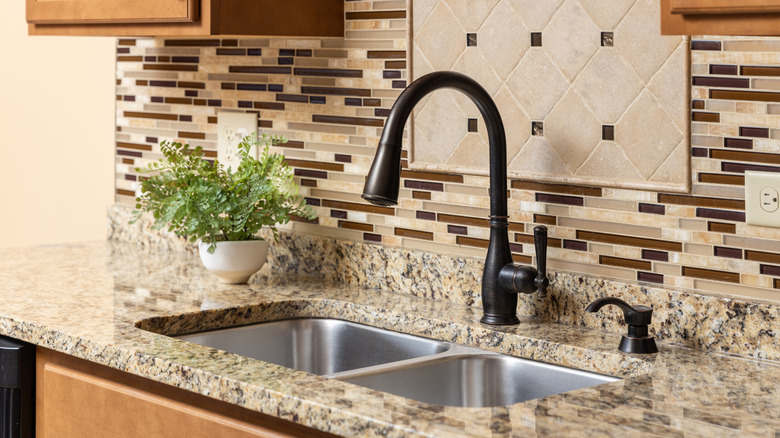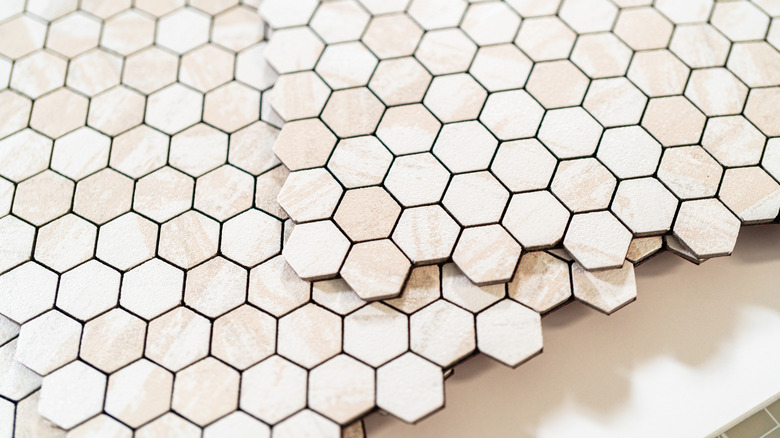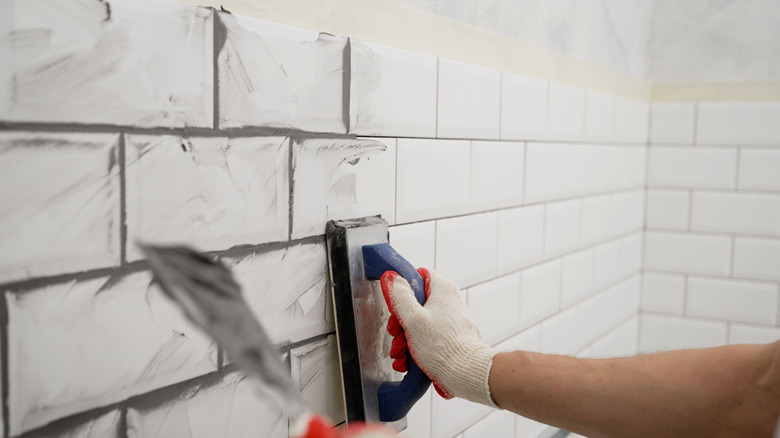Avoid One Common Mistake After Grouting Glass Tile To Save Your Hard Work
If you want to give your bathroom or kitchen a luxurious and unique look, then glass tiles may be right for you. Due to their durability and easy upkeep, glass tiles are the perfect low-maintenance option for your shower, backsplash, and more. When you purchase these tiles, you may be in a rush to install them and enjoy your finished work. However, be sure to take your time when grouting, as failing to allow your grout to dry completely is a common mistake that could ruin your project.
Irakli Khizanishvili, founder, owner, and CEO of Proslit Tile & Stone, exclusively told House Digest, "Grout requires time to set and harden to achieve its full strength and durability." This is especially important when it comes to glass tiles. This material is famously non-porous which comes with many benefits. One place where it can come back to bite you, though, is when grouting. As Khizanishvili explained, "Their non-porous nature slows down moisture absorption and evaporation. If the grout hasn't dried fully, it remains weak, which can lead to cracks, discoloration, or improper sealing."
The exact timeframe that grout takes to dry depends on factors like your grout type, temperature, and humidity levels. It's always best to follow your manufacturer's guidelines. Generally, Khizanishvili said that you can expect it to take 24 to 72 hours. If you're still unsure, he suggested "avoid[ing] surface contact for at least the first full day and check that the grout is firm to the touch and no longer damp-looking."
How to choose the best grout for glass tiles
You may be wondering, "Do I really need to use grout for tile floors?" It's understandable. Over time, grout may stain and become an aesthetic blight taking away from your tiles. But grout is necessary because it acts like a glue to prevent your tiles from shifting. This spares you from chipped and broken tiles. It also prevents moisture or debris from getting in between or underneath individual tiles. As mentioned, glass tiles are non-porous, which makes them resistant to common issues like mold, mildew, and stains. But, you still don't want water getting into those cracks.
When choosing grout for glass tiles, Khizanishvili exclusively told House Digest that a non-sanded grout is your best bet. Although non-sanded grout is more expensive than sanded grout, the latter may scratch your tiles. You can also make small choices that allow grout to add to your room, rather than take away from it. While you may be most familiar with black or white grout, it comes in a range of colors including browns, greens, and reds. To avoid visual inconsistency, Khizanishvili recommends picking one that complements your tiles. Before grouting your entire project, he also suggests testing your grout on a small portion of tile. That way, he explains, "[you can] ensure the grout won't cause discoloration or bonding issues."
More tips for properly grouting your glass tiles
Improperly grouting your glass tiles can alter their appearance beyond cracks and discoloration. As Khizanishvili exclusively told House Digest, "Any remaining moisture trapped during early use can cause staining or a cloudy appearance within the grout lines, which is especially noticeable with glass tiles due to their transparency and reflective surface."
However, you can properly grout your own tile by following a few tips. To start: For newly laid tiles, wait 24 to 48 hours before grouting to ensure that your mortar is set. Once it's dry, you can assemble your grouting tools, including a spreader tool (like a grout float), sponge, bucket, margin trowel, putty knife, and some cloths that you don't mind getting dirty. After, ensure that your tiles are also clean and free of any debris, and then mix your grout according to the manufacturer's instructions. To avoid issues, you should also work in sections, and only mix small amounts of grout at a time.
Once your grout is applied, Khizanishvili recommends wiping up any excess with a damp sponge after 10 to 15 minutes. However, be careful not to saturate the area because that can ruin the grout. After, you may consider sealing your tiles for further protection. Since glass is non-porous, you don't usually need to. But if you do, it's also important to follow the manufacturer's guidelines for application and proper drying times.


